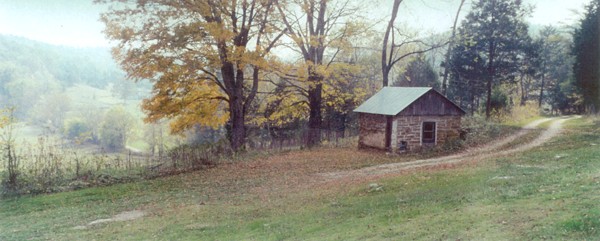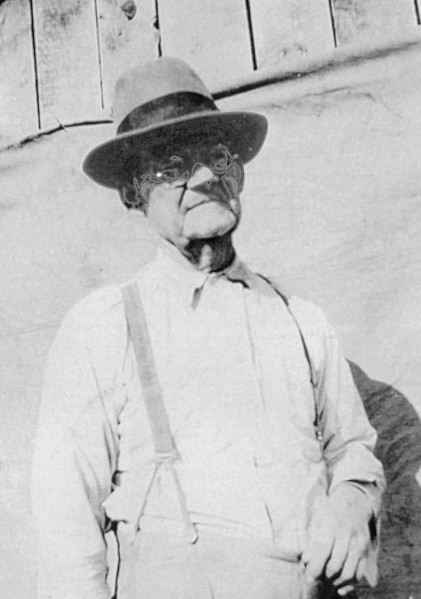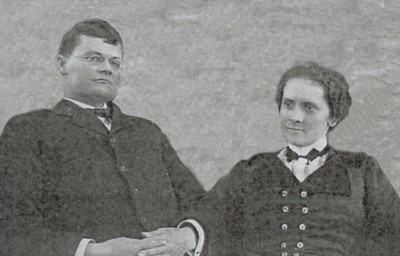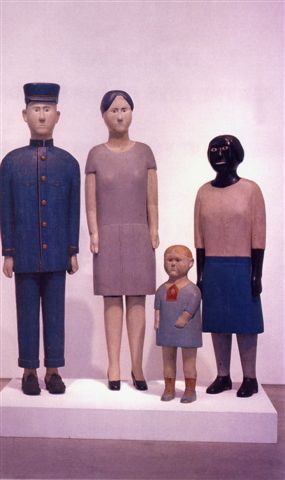|
But Mr. Lee’s interest wasn’t limited to wood carving.
He was also known for his artistic abilities. He drew political campaign
posters in pencil that were described as even better than anything printed
during that period of time. He was also an avid reader and the shelves in
his country store contained many classic novels. His reading materials
also included medical books, and he made a study of law as well. Writing
poetry was something else Mr. Lee did.
Joseph Cummings Lee died on May 10, 1941, at his home
after suffering a heart attack. The Buckeye Family was forgotten for a
while and left in a room of the general store or post office at Beaver
Hill. Then on August 18, 1962, a deal was made between Joe Lee’s son,
Beecher, and Thurman Tinch and Charles Tinch. Lee family members have a
handwritten receipt that Beecher Lee and his wife along with Thurman Tinch
and Charles Tinch all signed which shows an amount of $200.00 as being
paid by the Tinch brothers to Beecher Lee for the Buckeye Family. With
that transaction, the Buckeye Family left the possession of the Lee
family, and could be viewed at the Tinch watermill in Overton County for a
period of time. From information some the present Lee descendants have put
together, the ownership of the Buckeye Family has changed several times
over the years. The folk art family has since traveled many miles and has
been viewed by thousands of people since leaving the Tinch watermill.
Along the way, they were on display at the Brooklyn Museum. A newspaper
article published somewhere in California dated July 19, 1976, tells about
how curators at that museum swear that what was referred to as the
eerie-looking daughter, Shelby Jean, is supposedly haunted, and that she
walks around at night. The article went on to say that the Buckeye Family
traveled to that area as part of a show called "Folk Sculpture USA" held
at the Los Angeles County Museum of Art which highlighted over 100 pieces
made by self-taught artists throughout the country. Eunetta Jenkins, a
great-granddaughter of Joe Lee, has recently been in touch with the
present owners of the Buckeye Family, and has learned that they have
agreed to loan the family to the Frist Museum in Nashville for a show on
Tennessee art beginning September 13 of this year and running through
January of 2004. Personnel of the museum have already been to the home of
the owners to measure each item for shipping crates. The Lee family
members have all heard stories of how the Buckeye Family long ago had been
wrapped in quilts and hauled around in the back of wagons or other
vehicles, and to know now how royally they are being treated today makes
the fact that even though they no longer technically belong to the Lee
family, they are being handled with the utmost care and respect, both of
which they are well deserving of.
Just out of curiosity, I checked on the internet to
see if there was anything to be found there about the Buckeye Family, and
sure enough, under the website
www.antiquesandfineart.com/articles,
there they were. From such humble beginnings in 1925, to world wide
travelers via the net! Mr. Lee couldn’t possibly have imagined how his
folk art family, even after 78 years in existence, would be such sought
after works of art.
Wouldn’t it be wonderful if at some point the
Buckeye Family could eventually end up in the Overton County Historical
Museum? I think it would be very fitting since they started life in this
county and were crafted by someone who lived and served an area in Overton
County all his life. It’s unlikely that the Overton County Historical
Society would ever be able to purchase the Buckeye Family since members of
the Lee family has heard that the amount of money involved during the many
transfers of ownership has continued to escalate with each change of
hands, making the original transfer of $200.00 look like chicken feed in
comparison to their value today. I’m sure Mr. Joe Lee would be extremely
proud to know that his three years of labor spent to create this unique
family has achieved such notoriety since the time of their simple
beginnings which all came about through a request of a small boy and a
crudely carved wooden doll. And I can’t help but wonder too, what would
Mr. Lee’s son, Beecher, think of his father’s famous hand carved family
now?
I need to give credit for this story first of all to
Charles J. Cullom, formerly of Livingston, and who now resides in Orlando,
Florida. Mr. Cullom wrote to me with the suggestion that I do a story
about Joe Lee. (By the way, Mr. Cullom was Mayor of Livingston during the
years 1948-1951, as was his father in 1930.) Hugh Livingston and his wife, Joann, and Mrs. Opal Krantz
helped point me in the right direction. Joe Lee descendants that provided
a wealth of information as well as a very enjoyable afternoon in the home
of Juanita (Finley) Swack were invaluable to me in the preparation of this
writing. Those descendants include Mrs. Swack, a granddaughter of Joe Lee,
her daughter, Linda (Swack) King of Gallatin, and Mrs. Swack’s niece,
Eunetta (Finley) Jenkins of Cookeville, both of whom are
great-granddaughters of Joe Lee. Eva Lee Finley of Rickman, a
granddaughter-in-law of Joe Lee, also helped in providing information. My
sincere thanks to each one for their help.
Back to Josephine's Journal |



